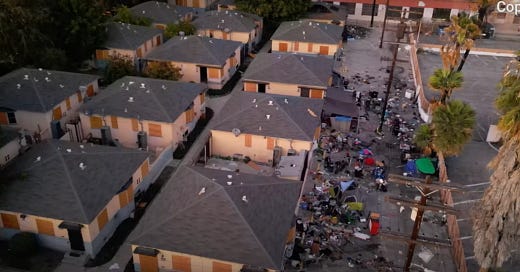36 RSO Units Gone
Older duplexes, triplexes, bungalow courts, and similar homes are an important source of naturally occurring affordable housing in Los Angeles. This is especially true in lower-income neighborhoods, and even more so in neighborhoods that have more families sharing such homes than single adults living alone or with only one other person.
Eighteen bungalow-style duplexes were built on Grand View Street in the 1940s, just below MacArthur Park. All 36 units were rent-stabilized. You can see them for yourself here, in a dronescape video made by Steve Lucero of The Artery LA and commissioned by my friends at Esotouric.
They're gone now, torn down for a proposed 100-unit building. The people and possessions visible in the alley could very well have been displaced from the demolished bungalows.
Of the 100 new units planned for the site, 25 are to be reserved for very low income households, with the rest reserved for low-income households (and one market-rate manager's unit). At least they won't be overpriced "luxury" units that no one in Westlake can afford. And at least there will be 47 family-sized apartments (two or three bedrooms).
One caveat: the project only allows for 25 parking spaces for 100 units. While I surmise some tenants will use the planned bicycle parking, and while I realize some Westlake residents may not own a car, this seems like a potential parking problem (would any Westlake residents care to opine?).
While the displaced RSO tenants are supposed to be eligible for relocation assistance, it doesn't change the fact that they were displaced in a city that is increasingly hostile to low-income renters, and that replacement units will not be available for some time.
A resident who appealed to save her home pointed out that the plan conflicted with the Westlake Community Plan. Objective 2 stated "To conserve and improve existing viable housing for persons desiring to live in Westlake, especially low- and moderate-income families." The city shot down the appeal cold, pointing to the eventual increase in the overall number of units.
There's another concerning objection in Appeal Point 5:
The affordable units of the Proposed Project are not available to those who are not full citizens [...] While I agree we do need more affordable housing, we don’t need affordable housing that is potentially discriminatory against those seeking citizenship in a community with a large number of people seeking citizenship. The housing choices for the people who will be displaced are already limited. This project will just continue to make our homeless crisis worse as our affordable housing is used to create discriminatory barriers.
I have submitted a CPRA request to verify whether it is true and accurate or not, and will update this entry accordingly.
However, the city's response is strange. Instead of debunking the appeal point, Staff Response 5 states:
This appeal point is not within the purview of the land use entitlements before the City. HCIDLA, in determining tenant eligibility for available affordable housing will follow local, state and federal laws, including the Fair Housing Act, which prohibits discrimination in housing, including refusing to rent or sell housing, because of race, color, national origin, religion, sex, familial status or disability.
So is it true or not? The city didn't specify, but I'll do my damndest to find out.
And if it is true, it seems like an awfully strange move to make in Los Angeles, since 35 percent of Angelenos are immigrants and becoming a naturalized citizen is a years-long process.
Oh, did I happen to mention you're paying for this?
I'm not kidding. California gave the developer $4.1 million in Proposition 1 funds. Then Mayor Bass got City Council to issue the developer a tax-free, low-interest bond. You, the taxpayer, are pitching in for this.
And those apartments are costing approximately $840,000 per unit.
That's a lot. And relocation expenses for displaced RSO tenants account for a chunk of that cost. If the development had been built in a place that did not have existing tenants (i.e. a former parking lot, strip mall, etc.), the cost would have been lower.
The housing situation in Los Angeles need not be an either/or binary. Development without displacement CAN exist - and for the sake of renters who aren't rich, it must. (Ditto for taxpayers who aren't made out of money.)
Ironically, the same developer is behind an even bigger affordable housing development in South LA. In that case, no housing was displaced because the land was previously used for a church. Three cheers for putting that site to good use, at least.



